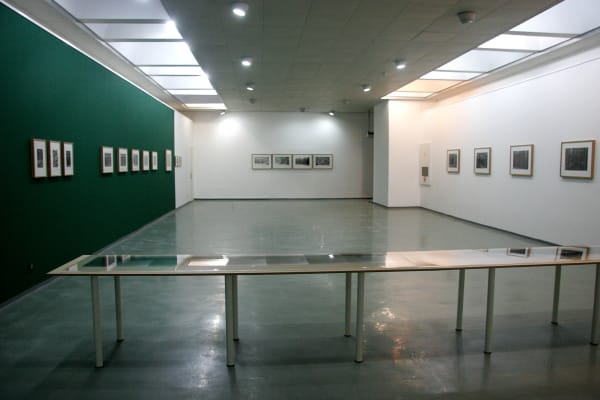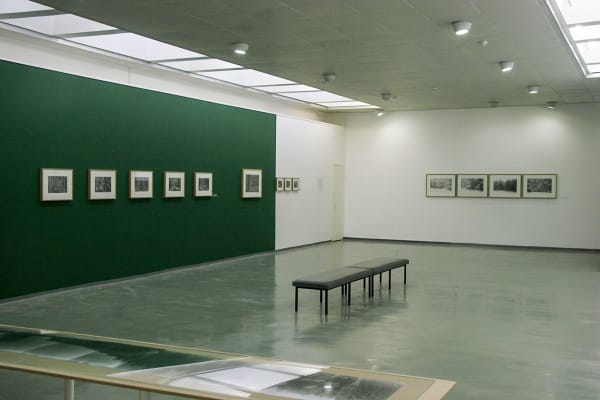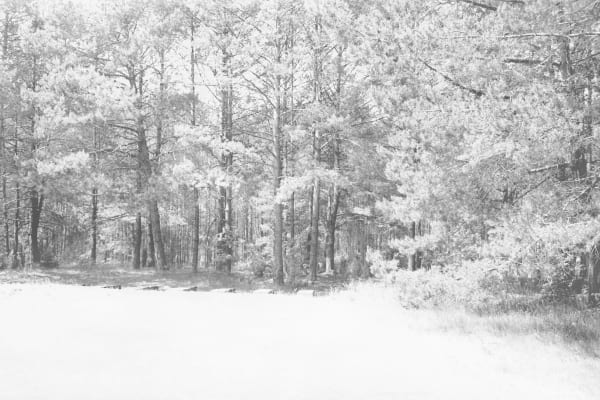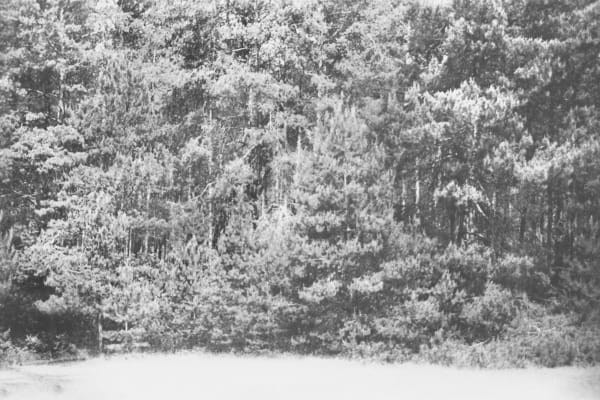The forest in the photographs is an intermediate state: it may appear or disappear, like an illusive memory
My Story
My father, Shmuel (Samek) Yannay, was born Shmuel Poznanski in Warsaw in 1921. On September 3, 1935, in possession of an immigration permit, he left for Palestine alone, taking a train from Warsaw to the port of Constanţa, Romania, where he boarded the steamship Polonia and sailed to his aunt in Haifa. On that railway platform in Warsaw he saw his mother, his father, his 21-year-old brother, his 16-year-old sister, and the rest of the family for the last time.
Without precise information, my father chose July 22, 1942, the day in which the mass deportation of Jewsfrom the Warsaw ghetto (the Great Aktion) began, as the day when his family was murdered in Treblinka, and lit Yahrzeit candles in their memory every year on that day.
In the 1980s, my father visited Poland with a relative. One day he disappeared. When he returned, he said that he had been to Treblinka. He went there, he said, to feel what they had felt. I followed in his footsteps, and I, too, went to Treblinka. Once as a visitor, and again as a photographer.
The day I arrived in Treblinka was a beautiful day. I left the monument area and headed for the surrounding woods. I was lured by the magic of the forest and light. I knew that this pastoral beauty concealed an atrocious truth. When one arrives in Treblinka, the view of the place fails to deliver its innate promise. To all appearances, there's nothing there but stones. But the stone is life, being, presence, and the forest is the monument and memory.
I love forests. Regrettably, there are none in Israel. In fact, it is hard to get lost in Israel.
The forest and the tree are the portrait of the place, and the light in the forest is an additional entity, another presence.
One of the photographs in the exhibition, an image of a solitary young tree I took in Treblinka, is akin to a family tree. Its leaves resemble diamonds glittering in the sun.
The family lies in the tree's freshness and the glittering of its leaves, in the forest's light.
The forest in the photographs is an intermediate state: it may appear or disappear, like an illusive memory, like an image which starts to appear in the developer tray in the dark room. If we are impatient, we will end up with nothing but a white image devoid of detail; if we leave it there and walk away, the image will grow blacker and denser and darkness will swallow everything up.
From the whiteness of the paper, through the many shades of gray, to the black; from the white forest to the black forest; in-between that which is no longer and those who are-still life, nature morte.
-

Video testimonial: Chavka Folman-Raban, A Journey Following Rumors Regarding the Treblinka Extermination Camp, Spring 1942
Director and Consultant: Moshe Ninio split screen, 6:21min, 2012 Read more -

Black and White Forest: Two Journeys to Treblinka
Exhibition Catalogue 2014Hard Cover 74 pagesRead more
Publisher: Ariel Yannay and The Ghetto Fighters' House - Itzhak Katzenelson Holocaust and Jewish Resistance Heritage Museum
ISBN: 978-965-394-126-7
Dimensions: 10.6x8.6 inch
![White Forest [White Panorama #1] [Treblinka]](https://artlogic-res.cloudinary.com/w_600,c_limit,f_auto,fl_lossy,q_auto/ws-artlogicwebsite1489/usr/images/artworks/main_image/items/24/24ba7b0a31d44dda918f3f570f6727d5/001-053-1.jpg)
![White Forest [White Panorama #2] [Treblinka]](https://artlogic-res.cloudinary.com/w_600,c_limit,f_auto,fl_lossy,q_auto/ws-artlogicwebsite1489/usr/images/artworks/main_image/items/1c/1c31aac65e104676a3eb572dd8351685/001-053-2.jpg)
![White Forest [White Panorama #3] [Treblinka]](https://artlogic-res.cloudinary.com/w_600,c_limit,f_auto,fl_lossy,q_auto/ws-artlogicwebsite1489/usr/images/artworks/main_image/items/2e/2efa578e71604c1881a8ac3e0a685b99/001-053-24.jpg)
![White Forest [White Panorama #4] [Treblinka]](https://artlogic-res.cloudinary.com/w_600,c_limit,f_auto,fl_lossy,q_auto/ws-artlogicwebsite1489/usr/images/artworks/main_image/items/80/801296655ac743869e72ac8be214037c/001-053-29.jpg)
![Gray Forest [#1] [Treblinka]](https://artlogic-res.cloudinary.com/w_600,c_limit,f_auto,fl_lossy,q_auto/ws-artlogicwebsite1489/usr/images/artworks/main_image/items/a1/a12eeba447f34ede8fb1daeef91c9aa2/001-054-6a.jpg)
![Gray Forest [#2] [Treblinka]](https://artlogic-res.cloudinary.com/w_600,c_limit,f_auto,fl_lossy,q_auto/ws-artlogicwebsite1489/usr/images/artworks/main_image/items/d8/d8b3c0ba5ae64efc96b04c0616893a99/001-054-7a.jpg)
![Gray Forest [#3] [Treblinka]](https://artlogic-res.cloudinary.com/w_600,c_limit,f_auto,fl_lossy,q_auto/ws-artlogicwebsite1489/usr/images/artworks/main_image/items/57/57302538f6e04a079914db44a10fe884/001-054-26a.jpg)
![Gray Forest [#4] [Treblinka]](https://artlogic-res.cloudinary.com/w_600,c_limit,f_auto,fl_lossy,q_auto/ws-artlogicwebsite1489/usr/images/artworks/main_image/items/27/274d6c3ea9044297848ad57fcb1e50e3/001-054-25a.jpg)
![Gray Forest [#5] [Treblinka]](https://artlogic-res.cloudinary.com/w_600,c_limit,f_auto,fl_lossy,q_auto/ws-artlogicwebsite1489/usr/images/artworks/main_image/items/d2/d209414425bc4bc291c32ce56973fa6e/001-054-24a.jpg)
![Black Forest #1 [Rumbula]](https://artlogic-res.cloudinary.com/w_600,c_limit,f_auto,fl_lossy,q_auto/ws-artlogicwebsite1489/usr/images/artworks/main_image/items/bc/bcf447749e244a50b8b17d0935ca9153/001-055-20.jpg)
![Black Forest #2 [Rumbula]](https://artlogic-res.cloudinary.com/w_600,c_limit,f_auto,fl_lossy,q_auto/ws-artlogicwebsite1489/usr/images/artworks/main_image/items/6c/6c52fdcd20bf4d37ade40addd573e08c/001-055-21.jpg)
![Black Forest #3 [Rumbula]](https://artlogic-res.cloudinary.com/w_600,c_limit,f_auto,fl_lossy,q_auto/ws-artlogicwebsite1489/usr/images/artworks/main_image/items/15/152954b405984fa4a1a28276a46e533a/001-055-18.jpg)
![Black Forest [#4], 2004](https://artlogic-res.cloudinary.com/w_600,c_limit,f_auto,fl_lossy,q_auto/ws-artlogicwebsite1489/usr/images/artworks/main_image/items/98/98d00e49702345bb9c646bc00ce5972d/001-055-32.jpg)
![Black Forest #5 [Rumbula]](https://artlogic-res.cloudinary.com/w_600,c_limit,f_auto,fl_lossy,q_auto/ws-artlogicwebsite1489/usr/images/artworks/main_image/items/d9/d954f8be07b34d1dbb0b48079b02570e/001-056-19.jpg)
![Black Forest #6 [Rumbula]](https://artlogic-res.cloudinary.com/w_600,c_limit,f_auto,fl_lossy,q_auto/ws-artlogicwebsite1489/usr/images/artworks/main_image/items/1f/1f0e53c6721a4d278bfb81f7a1a3d67c/001-056-20.jpg)

![Tree [Ayalon]](https://artlogic-res.cloudinary.com/w_600,c_limit,f_auto,fl_lossy,q_auto/ws-artlogicwebsite1489/usr/images/artworks/main_image/items/91/91306574d86b45278af0fa81ebb1b0c2/001-037-9a.jpg)
![Tree [Map] [Rumbula]](https://artlogic-res.cloudinary.com/w_600,c_limit,f_auto,fl_lossy,q_auto/ws-artlogicwebsite1489/usr/images/artworks/main_image/items/75/759a884651204b608355c3b0495d2220/001-055-30.jpg)
![Tree [Family Tree] [Treblinka]](https://artlogic-res.cloudinary.com/w_600,c_limit,f_auto,fl_lossy,q_auto/ws-artlogicwebsite1489/usr/images/artworks/main_image/items/31/31a70555966c48e996b1850f53cd08bf/001-054-22a.jpg)

![Ayalon [#1]](https://artlogic-res.cloudinary.com/w_600,c_limit,f_auto,fl_lossy,q_auto/ws-artlogicwebsite1489/usr/images/artworks/main_image/items/b2/b215e80175624d21ba67ad4c2b903671/001-038-01.jpg)
![Ayalon [#1]](https://artlogic-res.cloudinary.com/w_600,c_limit,f_auto,fl_lossy,q_auto/ws-artlogicwebsite1489/usr/images/artworks/main_image/items/97/9718f34e4f284e8cb5774b60fea82a32/001-038-02.jpg)
![Ayalon [#3]](https://artlogic-res.cloudinary.com/w_600,c_limit,f_auto,fl_lossy,q_auto/ws-artlogicwebsite1489/usr/images/artworks/main_image/items/3a/3aa0d843acb84caeb10317ccbf7cec66/001-038-03.jpg)
![Texture [Treblinka]](https://artlogic-res.cloudinary.com/w_600,c_limit,f_auto,fl_lossy,q_auto/ws-artlogicwebsite1489/usr/images/artworks/main_image/items/86/861970d1c67c4e20baacee3078c1209f/001-053-20.jpg)

![White Forest [White Panorama #1] [Treblinka]](https://artlogic-res.cloudinary.com/w_800,h_800,c_limit,f_auto,fl_lossy,q_auto/ws-artlogicwebsite1489/usr/images/exhibitions/group_images_override/9/001-053-2.jpg)




